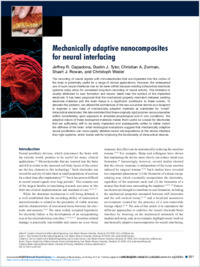Mechanically adaptive nanocomposites for neural interfacing
csal
- Capadona, Jeffrey R. Department of Biomedical Engineering, Case Western Reserve University, Cleveland, OH 44106, USA; jrc35@case.edu
- Tyler, Dustin J. Department of Biomedical Engineering, Case Western Reserve University, Cleveland, OH 44106, USA; dustin.tyler@case.edu
- Zorman, Christian A. Department of Electrical Engineering and Computer Science, Case Western Reserve University, Cleveland, OH 44106, USA; Christian.Zorman@case.edu
- Rowan, Stuart J. Department of Macromolecular Science and Engineering, Case Western Reserve University, Cleveland, OH 44106, USA; stuart.rowan@case.edu
- Weder, Christoph Adolphe Merkle Institute, University of Fribourg, Switzerland; christoph.weder@unifr.ch
-
2012
Published in:
- MRS Bulletin. - Cambridge University Press. - 2012, vol. 37, no. 6, p. 581-589
English
The recording of neural signals with microelectrodes that are implanted into the cortex of the brain is potentially useful for a range of clinical applications. However, the widespread use of such neural interfaces has so far been stifled because existing intracortical electrode systems rarely allow for consistent long-term recording of neural activity. This limitation is usually attributed to scar formation and neuron death near the surface of the implanted electrode. It has been proposed that the mechanical property mismatch between existing electrode materials and the brain tissue is a significant contributor to these events. To alleviate this problem, we utilized the architecture of the sea cucumber dermis as a blueprint to engineer a new class of mechanically adaptive materials as substrates for "smart” intracortical electrodes. We demonstrated that these originally rigid polymer nanocomposites soften considerably upon exposure to emulated physiological and in vivo conditions. The adaptive nature of these bioinspired materials makes them useful as a basis for electrodes that are sufficiently stiff to be easily implanted and subsequently soften to better match the stiffness of the brain. Initial histological evaluations suggest that mechanically adaptive neural prosthetics can more rapidly stabilize neural cell populations at the device interface than rigid systems, which bodes well for improving the functionality of intracortical devices
- Collections
- Language
-
- English
- Classification
- Chemistry
- License
-
License undefined
Copyright © Materials Research Society 2012 - Identifiers
-
- RERO DOC 302635
- SWISSBIB (NATIONALLICENCE)cambridge-10.1557/mrs.2012.97
- DOI 10.1557/mrs.2012.97
- Persistent URL
- https://sonar.ch/global/documents/305778
Statistics
Document views: 5
File downloads:
- S0883769412000978.pdf: 0
